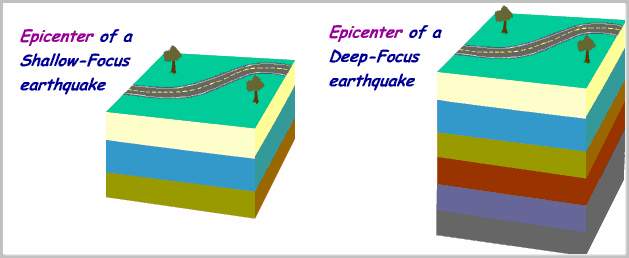An earthquake occurs when energy stored inside the earth gets released with great pressure . When this happens, earthquake waves transfer the released energy to the surface of the earth. In the process, physical and chemical changes occur deep within the earth. The tremendous geological forces acting upon the rocks and adjoining plates break the earth’s crust, thereby creating an earthquake with a sudden forceful impact.
SHALLOW FOCUS AND DEEP FOCUS EARTHQUAKES

Shallow-focus and Deep-focus earthquakes are both “tectonic” earthquakes originating within the earth’s depths at various points. They start from the foci. A focal point is where the geological fault has begun to rupture. The focus of an earthquake however differs from its epicenter, the latter being the point on the ground’s surface directly above the focus.
Beginning at the focus of the earthquake, body waves called seismic waves radiate outwards along the rupturing fault. All of the rock in the path of the wave is compressed and expanded alternately, as the waves travel along the fault at great speeds.
SHALLOW FOCUS earthquakes are commonly occurring “crustal” earthquakes, caused by faults and movements of the continental plates. These are earthquakes with their focus nearer the surface of the earth. Shallow focus earthquakes are usually of large spread, causing greater damage at the surface or the earth’s crust. These occur quite frequently and at random. However, being of smaller magnitudes and at lesser depths, very often they are not even felt. Nevertheless, about 75 % of the world’s energy released from earthquakes is from shallow-focus ones.
DEEP FOCUS earthquakes or “intra plate” earthquakes, occur within the sub-ducting oceanic plates as they move beneath the continental plates. Appearing along fault lines, these are earthquakes with focus much deeper within the earth. A deep focus earthquake occurs when two tectonic plates slide towards one another followed by subduction, or when the mineral olivine is in a transitional phase.These are typical of the subduction zone of the earth which are seismically active zones, often existing in patterns as in Wadati-Benioff zones. They happen as huge quakes with larger magnitudes, as a great deal of energy is released with the forceful collision of the plates.
The mechanics of these earthquakes have puzzled geophysicists, as brittle fracture and frictional sliding at depths exceeding 100-200 km would require great rock strengths which does not seem possible because of the high temperatures in such zones. They are believed to be associated with a catastrophic phase change as large portions of slab or slab-entrained material convert from spinal structure to a more compact perovskite structure.
DIFFERENCES
# Shallow focus earthquakes are called crustal earthquakes as they exist in the earth’s crustal layer. Deep focus earthquakes are known as intraplate earthquakes, as they are triggered off by collision between plates.
# Shallow-focus earthquakes occur at depths less than 70 km, while deep-focus earthquakes occur at greater focal depths of 300 – 700 km.
# Shallow focus earthquakes are found within the earth’s outer crustal layer, while deep focus earthquakes occur within the deeper subduction zones of the earth.
# While shallow focus earthquakes are of wider spread along the earths crust, deep focus earthquakes typically occur across great expanses and vertically as well.
# Shallow-focus earthquakes begin where the crustal plates of the earth are moving against one another. Whereas deep-focus earthquakes begin where one tectonic plate moves under another or sub-ducts, at the boundary of oceanic and continental plates.
# Shallow focus earthquakes are of smaller magnitudes, of a range 1 to 5, while deep focus earthquakes are of higher magnitudes, 6 to 8 or more.
# Shallow focus earthquakes are best measured using the traditional Richter scale which can record minor tremors too. However, deep focus earthquakes are best measured using the Moment Magnitude scale that has capacity to record earthquakes of magnitudes up to 10 on the scale.
# Less energy is released during a shallow focus earthquakes, while tremendous energy accumulates during a deep focus earthquake.
# However, the annual total energy released from the frequent shallow focus earthquakes exceeds that released from fewer happening deep focus earthquakes.
# During shallow focus earthquakes, rocks and plates buckle, deform and fault. While in the deep focus earthquakes, the rocks being at greater depths and extremely hot under high pressure, deform by flowing, rather than breaking and faulting.
# While shallow focus earthquakes happen frequently and at random within the earth’s crust, often going unrecorded, deep focus earthquakes occur every 20 to 30 years along a given fault line.
# Thus, while shallow focus earthquakes are barely perceived and are rarely destructive, deep focus earthquakes leave a deeper impact on civilization with widespread destruction and permanent changes within the earth’s geology, giving rise to tsunamis.
Thus the difference between the two type of earthquakes lies in the depths where the focus point of the earthquake originates and the associated dynamics.

